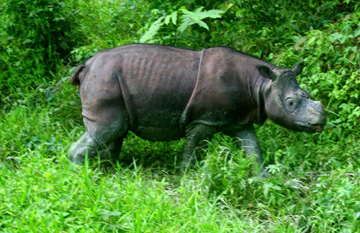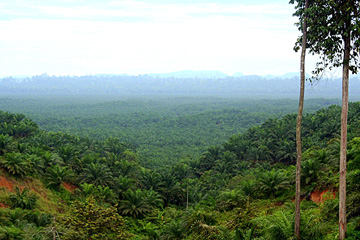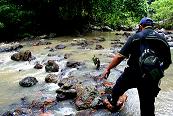The Rhino and Forest Fund (RFF) has partnered with the Forestry Department of Sabah in northern Borneo to launch a long-term reforestation project to aid Malaysia’s threatened species with particular emphasis on the Bornean rhino (Dicerorhinus sumatrensis harrissoni), one of the world’s most imperiled big mammals. The reforestation project will be occurring in and adjacent to Tabin Wildlife Reserve, which is surrounded on all sides by oil palm plantations.
“We see the charismatic [Bornean rhino] as a flagship species for the diverse lowland rainforest in Sabah. The signing is a major breakthrough to effectively combine the protection of endangered species like the rhino and the restoration of their natural habitat,” Dr. Petra Kretzschmar, co-founder of RFF, said in a press release.
The Bornean rhino is a subspecies of the Sumatran rhino (Dicerorhinus sumatrensis), classified as Critically Endangered by the IUCN Red List. After decades of extensive forest loss and poaching, the Sumatran rhino has dwindled to some 250, while the Bornean rhino is down to 50 animals at best. Already, one of the Sumatran rhino subspecies, the Northern Sumatran rhino (Dicerorhinus sumatrensis lasiotis), is likely extinct, though a few may survive in Myanmar.
 Researchers estimate that 250 Sumatran rhino survive in the world, and 40 or so Bornean rhinos, such as this captive male, named Tam. Scientists hope to pair Tam with a female to produce the next generation of Bornean rhinos, in an effort to save this species from extinction. Photo by: Jeremy Hance. |
“The Sumatran rhino remains on a trajectory to extinction. In Sabah, at least, not enough rhinos are being born to sustain the species. Protection work to prevent illegal hunting and trapping is a necessary activity, in order to prevent unnatural deaths of rhinos, but even more importantly, everything that can possibly be done, needs to be done, to boost rhino births,” explained Junaidi Payne with WWF-Malaysia to mongabay.com. Payne has been working with the Bornean rhino for years and is currently Executive Director of the Borneo Rhino Alliance (BORA).
While the Bornean rhino has become the focal species of the reforestation project, implementers hope the project serves a number of threatened species in Tabin, including orangutans, Bornean pygmy elephants, and the clouded leopard. The rapidly-vanishing forests of Borneo are considered some of the world’s most biodiverse, and Tabin Wildlife Reserve is no exception with a rare stand of old-growth forest still surviving in the park’s core area.
 The view overlooking Tabin Wildlife Reserve. In the foreground is oil palm plantations, in the background forest. Photo by: Jeremy Hance. |
“Sabah is a hotspot of biodiversity and therefore of global significance. If Sabah loses species, the whole planet will become poorer. So there should be global awareness, cooperation and action on an international level to stop species loss,” says Robert Risch, co-founder of the RFF.
Payne adds that the program brings much-welcome defenders to the fight to save Borneo’s wildlife, which is among the most besieged in the world.
“History shows that protected areas in Sabah have benefited from having at least one long term conservation-related program. It doesn’t matter exactly what the program entails—what is important is that the area has a high profile, and there will always be people ready and able to defend the integrity and significance of that area whenever it may come under threat,” says Payne.
The island of Borneo has lost approximately half of its forest cover in the past 50 years to oil palm plantations, pulp and paper, logging, and fires.
Related articles
Where two worlds collide: visiting Tabin Wildlife Reserve
(02/21/2010) The vehicle stopped on the way into Tabin Wildlife Reserve as a troupe of pig-tailed macaques began making their way across the road. In a flash a domestic dog, which may or may not have been ‘ownerless’, ambushed the group. Chaos erupted as the big predator fell upon the community. As quickly as it began it was all over and the dog was rushing over with an infant monkey in its mouth, leaving the macaques’ screeching out their helplessness. As my uncustomary welcome to Tabin Wildlife Reserve shows: the park is a meeting of two worlds. On the left side of the road leading into the reserve is a massive oil palm plantation, on the right is the rainforest and the many species the reserve protects. Tabin, therefore, gives the visitor a unique up-close view of the debate raging in Borneo and throughout much of Southeast Asia over conservation and environment versus oil palm plantations.
To save species, Malaysia implements daring plan to trap wild Bornean rhino

(06/13/2010) With less than 40 individuals left in the world, the Bornean rhino is a small step away from extinction. Yet conservationists and government officials in the Malaysian state of Sabah are not letting this subspecies of the Sumatran rhino go without a fight. Implementing a daring last-ditch plan to save the animal, officials are working to capture a wild female to mate with a fertile male named Tam, who was rescued after wandering injured into a palm oil plantation two years ago.
Fighting poachers, going undercover, saving wildlife: all in a day’s work for Arief Rubianto

(09/29/2010) Arief Rubianto, the head of an anti-poaching squad on the Indonesian island of Sumatra best describes his daily life in this way: “like mission impossible”. Don’t believe me? Rubianto has fought with illegal loggers, exchanged gunfire with poachers, survived four days without food in the jungle, and even gone undercover—posing as a buyer of illegal wildlife products—to infiltrate a poaching operation. While many conservationists work from offices—sometimes thousands of miles away from the area they are striving to protect—Rubianto works on the ground (in the jungle, in flood rains, on rock faces, on unpredictable seas, and at all hours of the day), often risking his own life to save the incredibly unique and highly imperiled wildlife of Sumatra.








